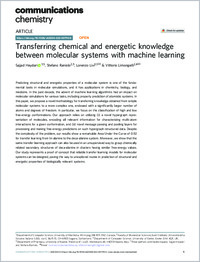Transferring chemical and energetic knowledge between molecular systems with machine learning
- Heydari, Sajjad ORCID Department of Computer Science, University of Manitoba, Winnipeg, Canada
- Raniolo, Stefano ORCID Euler Institute (EUL), Università della Svizzera italiana, Switzerland
- Livi, Lorenzo ORCID Department of Computer Science, University of Manitoba, Winnipeg, Canada - Department of Computer Science, University of Exeter, Exeter, United Kingdom
- Limongelli, Vittorio ORCID Euler Institute (EUL), Università della Svizzera italiana, Switzerland - Department of Pharmacy, University of Naples “Federico II”, Naples, Italy
- 2023
Published in:
- Communications chemistry. - 2023, vol. 6, no. 13
English
Predicting structural and energetic properties of a molecular system is one of the fundamental tasks in molecular simulations, and it has applications in chemistry, biology, and medicine. In the past decade, the advent of machine learning algorithms had an impact on molecular simulations for various tasks, including property prediction of atomistic systems. In this paper, we propose a novel methodology for transferring knowledge obtained from simple molecular systems to a more complex one, endowed with a significantly larger number of atoms and degrees of freedom. In particular, we focus on the classification of high and low free-energy conformations. Our approach relies on utilizing (i) a novel hypergraph representation of molecules, encoding all relevant information for characterizing multi-atom interactions for a given conformation, and (ii) novel message passing and pooling layers for processing and making free-energy predictions on such hypergraph-structured data. Despite the complexity of the problem, our results show a remarkable Area Under the Curve of 0.92 for transfer learning from tri-alanine to the deca-alanine system. Moreover, we show that the same transfer learning approach can also be used in an unsupervised way to group chemically related secondary structures of deca-alanine in clusters having similar free-energy values. Our study represents a proof of concept that reliable transfer learning models for molecular systems can be designed, paving the way to unexplored routes in prediction of structural and energetic properties of biologically relevant systems.
- Collections
- Language
-
- English
- Classification
- Chemistry
- License
- Open access status
- gold
- Identifiers
-
- DOI 10.1038/s42004-022-00790-5
- ARK ark:/12658/srd1328292
- Persistent URL
- https://n2t.net/ark:/12658/srd1328292
Statistics
Document views: 83
File downloads:
- Limongelli_2023_commchem_a: 141
